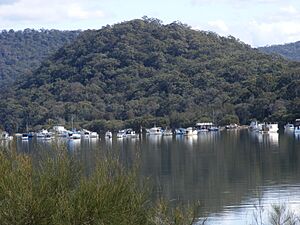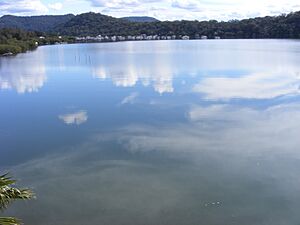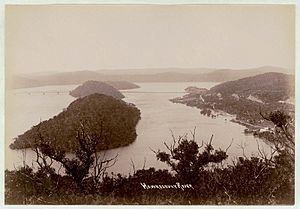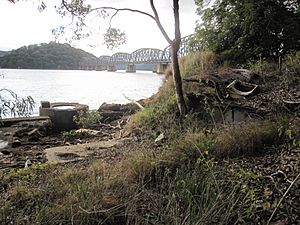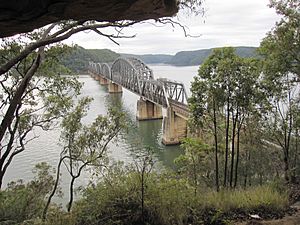Long Island (New South Wales) facts for kids
Long Island is a long, narrow island in the Hawkesbury River in New South Wales, Australia. It's about 50 kilometers north of Sydney's city center. The island is connected to the mainland by a railway bridge at its southeastern end. This bridge leads to the Sydney suburb of Brooklyn, which is part of Hornsby Shire. Long Island is also part of Hornsby Shire.
Other islands nearby in the Hawkesbury River include Dangar Island, Spectacle Island, Milson Island, Peat Island and Lion Island.
Just like Spectacle Island and Lion Island, Long Island is a special nature reserve. This means it's a protected area, and you need special permission from the N.S.W. Office of Environment and Heritage to visit. The New South Wales Parks and Wildlife Service sometimes offers guided tours. These tours are for people who want to learn about the island's plants, animals, rocks, and its Aboriginal history.
You can get some of the best views of Long Island from places like Lloyd Trigonometrical station and Tipper's Lookout. These spots are located to the west in the nearby Muogamarra Nature Reserve. From there, you can look down the whole length of the island and see the mouth of the Hawkesbury River and Broken Bay far away.
Long Island was added to the Australian National Heritage List in December 2006. This list recognizes places that are very important to Australia's history and nature.
Island History
The area around Long Island has been home to the Guringai people for thousands of years. They left many signs of their life on the land. These include hundreds of rock carvings, places where they sharpened stone tools, cave paintings, and shellfish middens (piles of shells from their meals).
The first European to see this area was Governor Arthur Phillip. He explored the lower river by boat in March 1788. At first, the local Guringai people were friendly. However, when he returned a year later, they avoided contact with him. By 1790, more than half of the Guringai people had become sick and died from smallpox. This disease was brought by the British settlers.
Early European settlers on the island included people who cut down trees for timber. By 1873, there were two houses on the island. These belonged to George Woods and Albert Nelson. Nelson was a lime burner and ran a boarding house.
In 1911, the island was given to Hornsby Council. It was then used as a recreation area, mostly by fishermen. The main part of the island, away from the railway line, was later made a nature reserve in 1972.
The Railway on Long Island
The Main North railway line, which connects Sydney to other places, goes through a tunnel on the eastern side of Long Island. The island is linked to Brooklyn by a railway bridge over Sandbrook Inlet. It's also connected to Cogra Point on the northern shore of the Hawkesbury River by the second Hawkesbury River Railway Bridge.
The parts for this second bridge were put together on the northeastern side of Long Island. This happened in the 1940s, when the first bridge needed to be replaced. You can still see the remains of the docks and crane bases on the hillside and along the water's edge.
Right next to the current railway tunnel is the first railway tunnel. This tunnel was dug through the island as part of the approach for the first Hawkesbury River Railway Bridge. This old tunnel and its railway tracks were no longer used after the new bridge was finished in 1946.
How Long Island Got Its Name
People used to wonder how Long Island got its name. Some thought it was named because of the first Hawkesbury River Railway Bridge, which was built by the Union Bridge Company from Buffalo, New York in the 1880s. However, there is clear proof that the name was used much earlier, at least sixty years before the bridge was built.
The island was named by a surveyor named W.R. Govett in 1829. He called it "Long Island" because of its shape. It is long and narrow, about 2 kilometers long and 300 meters wide.
There are also older mentions of the name in newspapers. For example, in 1863, a newspaper mentioned an investigation on nearby Dangar Island for a drowned man. He was described as "John Foley, a woodman residing at Long Island, at the mouth of the Hawkesbury, ...". Another report from April 1880 talked about a local surveyor, Mr. Burdett, who was "... camped on Long Island, from whence he lays the surrounding country under contribution to his theodolite". These old records show that the name "Long Island" was already in use long before the railway bridge was built.


